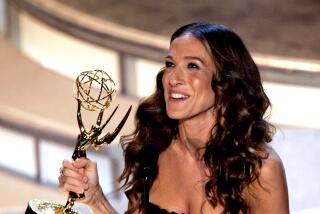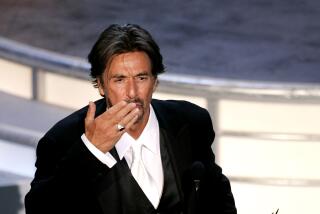Memorable moments from past Oscars
With the 87th Academy Awards almost upon us, we look at some of the memorable moments that took place during the 86 previous shows — both onstage and off. Today’s Oscars are a well-oiled machine — give or take a John Travolta-Adele Dazeem moment or two — but that was not always the case.
The Envelope, please
There were no sealed envelopes during the Oscars’ first decade. In fact, the winners of the first ceremony were announced three months in advance. And the Academy of Motion Picture Arts and Sciences would give local papers the names of the winners the day of the ceremony with the caveat that they didn’t print them until after the awards were over.
------------
FOR THE RECORD:
Oscars history: A Feb. 22 article about memorable Oscars moments misstated the category for which John Wayne presented the award in 1979. He announced the winner for best picture, not director. Also, a photo caption misidentified William Holden’s wife, Brenda Marshall, as Brenda Joyce. —
------------
But the Los Angeles Times jumped the gun publishing the winners of the 12th Academy Awards on Feb. 29, 1940, in the 8:45 p.m. edition. So most of the attendees knew entering the Ambassador Hotel’s Cocoanut Grove that “Gone With the Wind” was the evening’s big winner. After that snafu, the academy began the sealed-envelope tradition.
FULL COVERAGE: Oscars 2015
And the winners are ... where?
Claudette Colbert was nominated for lead actress for the comedy “It Happened One Night” but didn’t think she had a chance to win, so booked a cross-country railroad trip to New York City. Colbert was at the station on Feb. 27, 1935, while the Academy Awards were being held nearby at the Biltmore Hotel in downtown Los Angeles. After host-presenter Irving S. Cobb announced she had won, an academy official tracked down Colbert at the station and whisked the actress, dressed in a travel suit, to the Oscar ceremony. She received her award, quickly posed for pictures with child star Shirley Temple, and then got back on the train.
------------
FOR THE RECORD:
Oscars history: A Feb. 22 Calendar article about memorable Oscars moments misstated the category for which John Wayne presented the award in 1979. He announced the winner for best picture, not director. —
------------
Luise Rainer managed to wear a gown but forgot to put on makeup before she arrived with her playwright husband, Clifford Odets, at the Oscar ceremony on March 10, 1938. Rainer had been relaxing at home when she got the call she had won her second Academy Award in a row for lead actress for “The Good Earth” and needed to get down to the Biltmore Hotel posthaste to accept the award.
Oscar during the war
After handing out Oscars during a banquet for the first 15 years, the Academy Awards moved to the venerable Grauman’s Chinese Theatre for the March 2, 1944, ceremony. Such enlisted stars as William Holden attended in dress uniform, and the extra seating enabled the academy to invite men and women serving in World War II to the ceremony in which “Casablanca” received best picture honors.
PHOTOS: Oscars 2015 top nominees | Presenters | Nominee reactions | Awkward moments
The show must go on
After holding the Academy Awards in 1947 and 1948 at the 6,000-plus seat Shrine Auditorium, the 21st ceremony on March 21, 1949, moved to the intimate Academy Award Theatre in Hollywood. The reason? The major Hollywood studios, including MGM, Paramount, Warner Bros. and 20th Century Fox, decided to pull the plug on their financial support. According to “85 Years of the Oscar” by Robert Osborne, they had withdrawn funds “in order to remove rumors that they had been trying to exert their influence over voters.”
Hey, lady!
With the Oscars generally clocking in at 31/2 hours, it’s hard to believe one televised Oscars show actually came up 20 minutes short. But a shorter Oscars was not necessarily a better Oscars.
Bob Hope, David Niven, Tony Randall, Mort Sahl, Laurence Olivier and Jerry Lewis were the hosts for the 31st Academy Awards on April 6, 1959, at Hollywood’s Pantages Theatre. The show’s final emcee, Lewis, ended up having to stretch out the evening. Lewis kvetched and brought out all the winners and presenters on stage, which included his old partner, Dean Martin, who kept a healthy distance from Lewis.
“And they said Dean and I wouldn’t be on a stage together again,” Lewis cracked.
Lewis took over for conductor Lionel Newman and led the orchestra in the song winner, “Gigi.” The stars on stage began dancing: Rosalind Russell cut a rug with Maurice Chevalier, Randall was paired with Eva Marie Saint and Martin danced with Sophia Loren as the audience began filing out. Time’s Richard Corliss said of the show: “Until Nixon’s 181/2, Lewis’ 20 were the minutes that lived in pop-culture infamy. Catastrophe would be the one way to describe it.” Lewis, who had emceed twice before, never hosted again.
Golden moments
There have been many emotional, dramatic moments at the Oscar ceremonies over the decades. The 33rd Academy Awards on April 17, 1961, saw Elizabeth Taylor, shaky and frail from a near-fatal bout of pneumonia, accept her lead actress Oscar for “Butterfield 8” onstage at the Santa Monica Civic Auditorium. Taylor later said: “When they called my name, I got up and could hardly walk. I’d just come back from London, where I had nearly died of pneumonia. I got to the stage, and I hadn’t prepared a thing.”
That same evening, Jimmy Stewart accepted Gary Cooper’s honorary award for “his many memorable screen performances and the international recognition he, as an individual, has gained for the motion picture industry.” Stewart gave an emotional speech about his good friend, who was losing his battle to cancer. “I’ll get this to you right away,” Stewart said looking into the camera. Cooper died a month later at age 60.
Just two months before his death from cancer at age 72, a startlingly thin John Wayne appeared on the 51st ceremony on April 9, 1979, to hand out the best director Oscar. After a warm standing ovation, Wayne told the audience at the Dorothy Chandler Pavilion: “Oscar and I have something in common. Oscar first came to Hollywood in 1928; so did I. We’re both a little weather beaten, but we’re still here and plan to be around for a whole lot longer.”
OSCARS 2015: Complete list | Ballot | Cheat Sheet | Top nominees | Presenters | Timeline
Palate cleanser?
This year’s Governors Ball will feature such Wolfgang Puck creations as smoked salmon Oscars, chicken pot pie with shaved black truffles and mini American Wagyu burgers. So what did the Hollywood elite consume at the first Academy Awards on May 16, 1929? According to “85 Years of the Oscar,” the black-tie dinner ceremony — tickets were $5 — at the Blossom Room at the Hollywood Roosevelt Hotel featured filet of sole saute au beurre, half broiled chicken on toast, new string beans, long branch potatoes and consomme Celestine.
Oops!
Sammy Davis Jr. did impressions of Jimmy Stewart, Edward G. Robinson and Jerry Lewis before he announced the nominees for the first of two musical scoring Oscars at the 36th Academy Awards on April 13, 1964, at the Santa Monica Civic Auditorium. He read the nominees for the first award — scoring of music, adaptation or treatment — opened the envelope and proudly announced that John Addison had won the Oscar for “Tom Jones.” The problem was Addison actually had won the Oscar in the music score, substantially original category.
“They gave me the wrong envelope?” asked Davis, as a representative of Price Waterhouse quickly came out with the envelope that had the correct winner — Andre Previn for “Irma la Douce.”
“Wait’ll the NAACP hears about this!” he quipped.
More to Read
Only good movies
Get the Indie Focus newsletter, Mark Olsen's weekly guide to the world of cinema.
You may occasionally receive promotional content from the Los Angeles Times.











